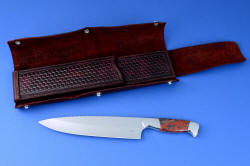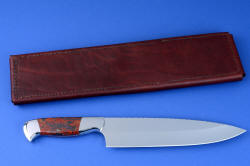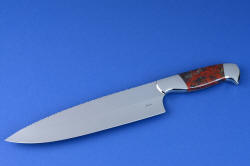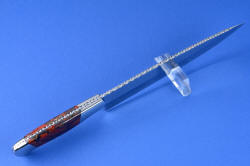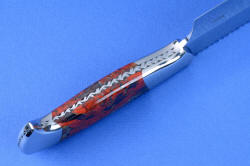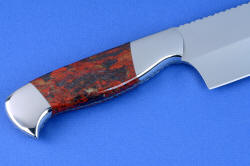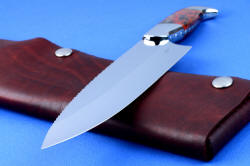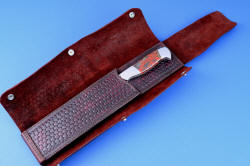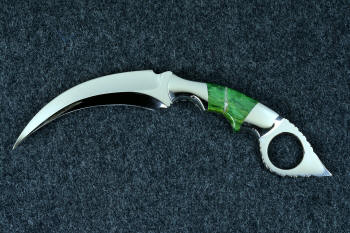Concordia
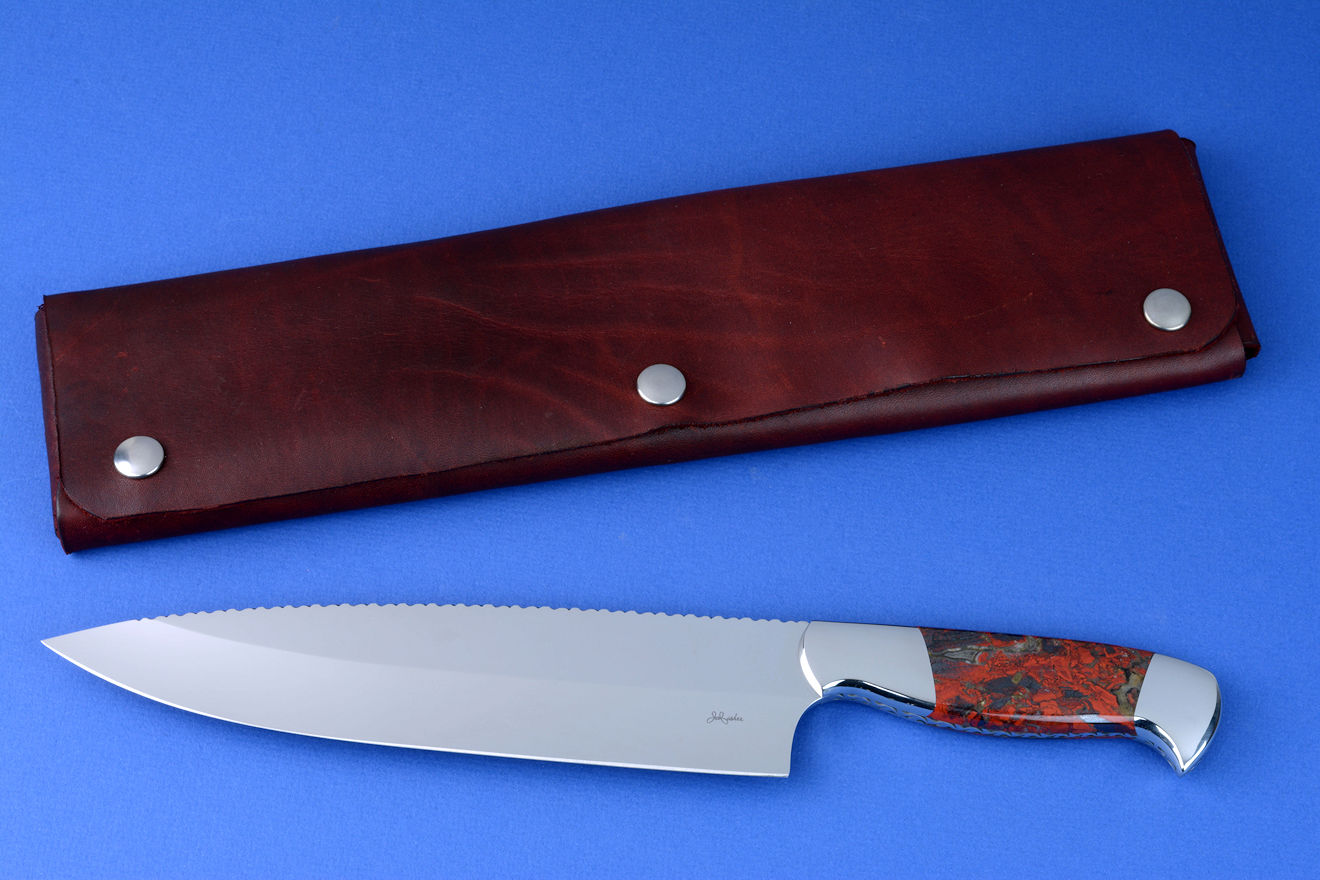
"Concordia" Master Chef's Knife
- Size: Length overall: 13.6" (34.6 cm), Blade Length: 8.75" (22.2 cm), Maximum Blade Width: 1.9" (4.8 cm), Thickness (max): .151" (3.8 mm)
- Weight: Knife: 15.1 oz. (428 grams) Sheath: 13.1 oz. (371 grams)
- Blade: CPM154CM High Molybdenum Powder Metal Technology Martensitic Stainless Tool Steel, Cryogenically Treated, Hardened and Tempered to 62HRC
- Bolsters, Fittings: 304 Austenitic Stainless Steel
- Handle: Brecciated Jasper Gemstone from the Painted Suguta Valley, Kenya, Africa
- Sheath: Hand-tooled leather shoulder, Latigo leather side
- Knife: How would the best chef's knife made
look: a knife with timeless simplicity, but made to the highest
possible technical standards, with the finest materials in the
absolute highest process and control of geometry, treatment, and
finish? The Concordia is named for the Roman
goddess of harmony. This is the ultimate in a readily recognizable
form of master chef's knife, and I made this one the best it can
possibly be. While simple in presentation, this knife is extensive
in critical features that make it, simply, one of the best chef's
knives made. This starts with the blade. This is an extremely fine
steel, one of the best made by the most refined and controlled
process known today. This is CPM154CM, an extremely high alloy tool
steel, made by the powder metallurgical process. It's high in
chromium so is a true stainless steel, and the chromium forms
extremely hard chromium carbide particles in the matrix, increasing
the wear resistance over other stainless steels by a wide and
significant margin. Also in the alloy is molybdenum which not only
creates molybdenum carbides that are more wear resistant than the
chromium carbides; but also the molybdenum amplifies the toughness, or resistance to
fracture throughout the blade. This is critical on the
microscopic scale of the cutting edge, for a substantial reduction
in wear. So the blade can be made much harder,
with a greater abundance of martensite and carbides overall, with
increased toughness. To bring out the best in this steel, I gave it
a deep cryogenic treatment (quenching) in liquid nitrogen at 325
degrees below zero Fahrenheit, and a full 40 hour cryogenic
aging for complete transformation of allotropes and maximum
precipitation of all carbides. This was followed by three tempering
cycles with deep cryogenic cycling (at -325°F) in between for maximum toughness
and thermal conditioning. With this proprietary treatment, this high
technology steel blade is the absolute best it can possibly be for
this application. It's tough, it's durable, it's extremely hard and
wear resistant. It's also extremely corrosion resistant as well,
critical for the professional chef's use: clean and bright for
food service and exposure. There will be no corroding, no rusting,
no metallic particles from this knife into any food, and this is the
reason these extremely fine steels should be used by all the best
chefs. When I created the blade, I was determined to fabricate as thin a
blade as possible to support the extremely fine and thin razor-keen
cutting edge. The grind behind the relief (the visible part of the
cutting edge) is a mere .030" thick (.77 mm), and the relief behind
the cutting edge itself is .015" (.39 mm) thick! This is a very
thin working edge, supported by a strong spine so the blade won't
flex in use. The hollow grind is very deep, so that repeated
sharpenings (seldom though they may be) will yield significant
thinness of the blade for literally decades to come. The blade has a
perfect sweep of the belly for rocking on the board, and a good
length of straight edge for dicing and handwork. The heel drops a
full inch (2.5 cm) from the forefinger position to keep the hands
off the board, and a slight curve at the heel adds a bit of safety
to the incredibly sharp blade grind termination. I ground the knife
through many steps to achieve a bright, mirror polish which shows no
grain in the steel, while preserving a crisp grind line throughout,
matched on both sides. The blade is a full tang model, a solid piece
of steel from tip to butt, and the gentle taper in the handle
balances the weight. The entire spine is embellished with simple,
clean vine filework, not too deep for easy cleaning yet enough to
give a gentle purchase in the grip and while touching the spine for
support. I bolstered the knife with high nickel, high chromium
304 austenitic stainless steel bolsters and pins, for the ultimate in
security and strength, with zero-care and absolutely no possibility
of corrosion, ever. This is the same stainless steel used in nuts,
bolts, and fasteners, and is a National Sanitary Foundation standard
in the kitchen as well. The bolsters are substantial enough to do
their job strengthening the handle and giving an area for pressure
to be applied to the blade, while being thin enough to balance the
weight. They are clean, rounded, smoothed, and polished, and are
dovetailed to bed a pair of stunning gemstone handle scales. This is
Brecciated Jasper from the Great Rift Valley (Suguta) in Kenya,
Africa. This stone was once the sediment of a great ocean bearing
iron (thus the red), that was churned under, and broken to pieces,
crushed, and then reformed under intense geological processes that
are hard to imagine. It is a microcrystalline quartz, with
inclusions of metallic hematite and fascinating patterns and is
solid, hard, and tough, taking a bright lustrous polish. This is a
gemstone that will literally outlast the knife. It's fitted
perfectly to the stainless steel of the tang and bolsters,
distinctive and bold. The knife feels great in the hand, with the
balance point at the face of the front bolster, surprisingly
well-balanced for such a large blade. The knife in the hand begs to
be used!
- Sheath: I wanted a special rig for this piece, one that was as clean and
elegant as useful for this superb knife. I decided I would make a
chef's roll type of transport and protection vehicle. I built the
inside of the sheath in heavy 9-10 oz. leather shoulder, hand-tooled
and dyed a burgundy to compliment the gemstone color and give a warm
appeal. I hand-tooled the heavy shoulder faces with a tri-weave
pattern, bordered by camouflage, both for the sheath blade body and
the handle rest. The knife slips smoothly in this interior sheath
while offering great safety to the owner, with just the handle
accessible. The interior sheath is hand-stitched with polyester
sinew through the welts and to the wrap, so that no parts will ever
move, and there is no play in the entire assembly. I made the wrap
from burgundy latigo side, a leather with limited flexibility, color
throughout, and great sealing and wear properties. This is a leather
that can take a beating and still look great, through many, many
years of service with little care. The handle flap folds over to
protect the handle and prevent the knife from unsheathing, and the
latigo side folds over the entire affair to secure it. I even used
all stainless steel dot snaps, marine grade, for the ultimate in
corrosion resistance and longevity.
- An extremely fine knife, made for the professional, for service, beauty, and longevity.
Thanks, T. S.!
I received the knife, it is absolutely gorgeous.
I am kind of not wanting to dirty it up. LOL
-T.
Please click on thumbnail knife photos
